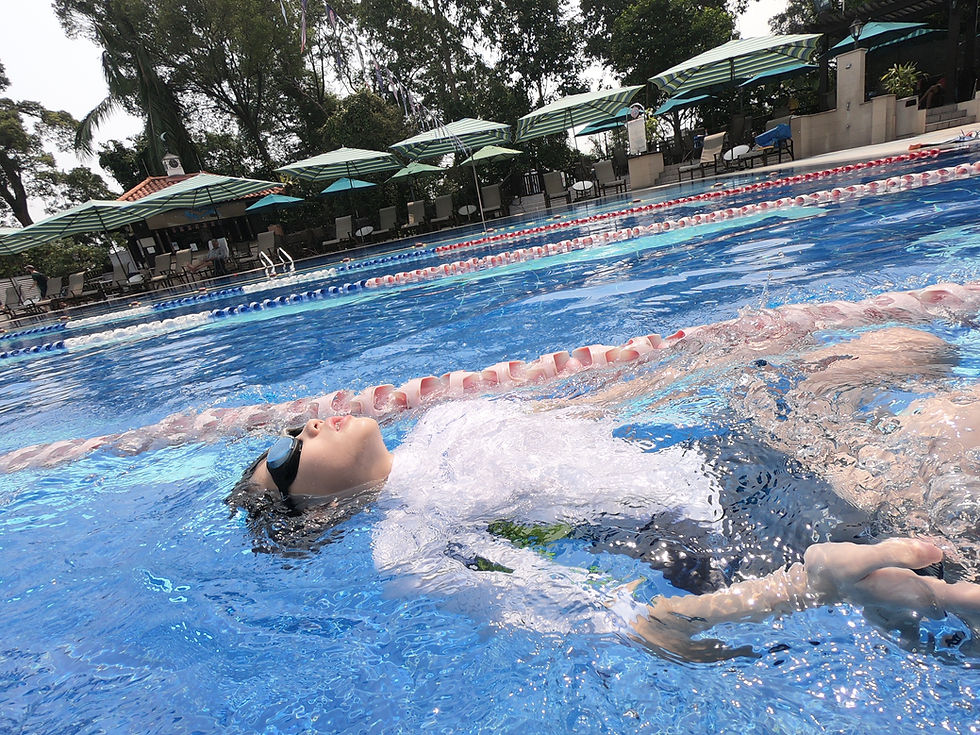How to Set and Achieve Goals for Self-Learned Backstroke
- SG Sink Or Swim

- May 23
- 3 min read

Teaching yourself backstroke is an impressive and empowering endeavor. Unlike learning with a coach, self-directed swimmers must rely on clear goal-setting, consistency, and self-feedback to improve technique, build endurance, and track progress. Whether you’re a beginner aiming to swim 50 meters nonstop or an experienced swimmer fine-tuning your stroke, setting the right goals is the foundation of success.
This article outlines how to set, measure, and achieve realistic goals for learning and mastering the backstroke on your own.
🎯 Why Goal-Setting Is Crucial for Self-Taught Swimmers
When you’re learning solo, there’s no one to correct your form or hold you accountable—your goals become your coach. Clear, structured goals help you:
Stay focused and motivated
Track technical and physical progress
Break big objectives into manageable steps
Prevent frustration or burnout
Celebrate tangible achievements along the way
🧱 Step-by-Step: How to Set Backstroke Goals That Work
✅ Step 1: Define Your "Why"
Start with your motivation:
Do you want to swim backstroke in a race or triathlon?
Are you trying to improve technique or build endurance?
Is your goal to add backstroke to your overall swim repertoire?
Knowing your "why" gives purpose to your practice.
✅ Step 2: Set SMART Goals
Use the SMART framework to make your goals:
Specific | Define exactly what you want to achieve (e.g., “Swim 100m backstroke with correct technique”) |
Measurable | Track progress with time, distance, or repetition |
Achievable | Make sure the goal matches your current skill level |
Relevant | Align it with your broader swim or fitness goals |
Time-bound | Set a deadline (e.g., “within 6 weeks”) |
✅ Step 3: Break It Down Into Skill Categories
Your self-learned backstroke progress should target the following key areas:
Body Position
Goal: Maintain horizontal alignment without hips sinking.
Drill: Kick with hands by your sides to feel balance.
Kick Technique
Goal: Perform a steady flutter kick from the hips.
Drill: Vertical kicking or streamline kick with fins.
Arm Timing and Recovery
Goal: Alternate arms smoothly with proper hand entry (pinky first).
Drill: Single-arm backstroke drill.
Breathing and Head Position
Goal: Keep head still, eyes up, breathing relaxed.
Drill: Use a water bottle on your forehead to practice head stability.
Turns and Push-Offs (Advanced)
Goal: Perform a legal backstroke flip turn and streamline push-off.
Drill: Wall approach drills with flip practice.
✅ Step 4: Track Progress Weekly
Create a swim log with the following fields:
Date
Distance swum
Focus of the session (e.g., kicking, timing)
Drills used
What felt better?
What needs work?
✅ Use video recording when possible to review and adjust technique.
✅ Step 5: Celebrate Milestones
Mark small wins like:
First 25m without stopping
Mastering a smooth arm entry
Holding technique for an entire 100m swim
Completing your first backstroke set with accurate stroke counts
🎉 Recognition keeps motivation high and builds confidence.
🏁 Sample Goal Progression for Self-Taught Backstroke Swimmer
Week | Goal |
Week 1–2 | Swim 4x25m with focus on horizontal body position |
Week 3–4 | Add consistent flutter kick for 50m |
Week 5–6 | Record and improve arm recovery technique |
Week 7–8 | Swim 4x50m with efficient stroke count |
Week 9+ | Practice backstroke flip turns and streamline push-offs |
🧠 Pro Tips for Self-Learners
🔁 Practice drills before full stroke sets to isolate skills
🎥 Use video feedback (phone or waterproof action cam)
🧘 Work on flexibility and shoulder mobility to improve recovery
⏱️ Use a tempo trainer to develop stroke rhythm
🏊 Watch elite backstroke videos to visualize ideal form
📌 Final Thoughts
Learning backstroke on your own is absolutely possible—with a plan. By setting clear goals, tracking your progress, and focusing on technique before speed, you’ll steadily improve and gain confidence in the water. Backstroke is not just about strength — it’s about control, coordination, and rhythm, all of which can be developed with patience and consistency.





Comments